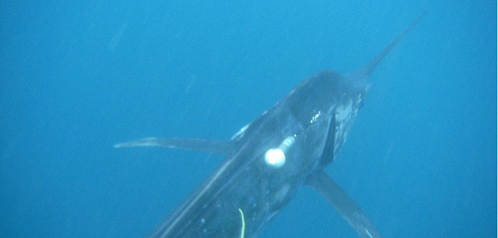← Back
Billfish movement patterns revealed with Argos pop-up satellite tags

Dr. Wei-Chuan (Riyar) Chiang of Fisheries Research Institute, Taiwan, will share the results of his studies on “Vertical and horizontal movements of billfish in the northwestern Pacific Ocean determined using pop-up satellite tags” at the 2nd Argos Asian Wildlife Tracking Workshop in Incheon, Korea.
To investigate movement patterns, habitat and thermal niche, pop-up satellite archival tags were deployed on five species of billfish (black marlin, blue marlin, sailfish, striped marlin and swordfish) using harpoon, longline and set-net fishing gear in southeastern Taiwan.
Revealing billfish migration patterns

Map of striped marlin linear displacements with SST data. Map from Wei-Chuan Chiang, Fisheries Research Institute, Taiwan.
Linear displacements ranged from 73 to 3,579 km from deployment to pop-up locations with speeds of 0.1 to 9.6 km/h. Most probable tracks (MPTs) calculated by the Kalman filter suggest that swordfish moved south after release whereas black marlin undergo distinct seasonal movement patterns.
For sailfish, all movements were confined to the East China Sea, and striped marlin moved to South China Sea. No seasonal movement patterns were observed in blue marlin but MPTs from the longest deployments revealed highly variable movement patterns. Regardless of tagging location or season of release, none of the tagged billfishes travelled to the central Pacific Ocean.
Recording dive depth data
Diving depths and ambient water temperature ranged from the surface to 737 m and from 6°C to 33°C. All species showed oscillatory dive behavior from the surface mixed layer to as deep as ~200 – 700 m and clear diel patterns occupying shallower depths at nighttime than during daytime. Comparative vertical niche is discussed among the species.
Learn all about his work in Incheon, Korea, from July 4th-5th !
Dr. Wei-Chuan (Riyar) Chiang, Ph.D.

Wei-Chuan (Riyar) Chiang
Dr. Wei-Chuan (Riyar) Chiang is an associate researcher (Billfish Biologist) at the Fisheries Research Institute of Taiwan and an adjunct assistant professor at National Taitung University. He studied at the Institute of Oceanography, National Taiwan University, Taipei, Taiwan 1998, and obtained his Ph.D. in 2004. The topic of his Ph.D. thesis: Population dynamics and stock assessment of the sailfish (Istiophorus platypterus) in the waters off eastern Taiwan. Dr. Chiang’s research interests today are broadly focused on fisheries interaction, biology, and trophic ecology of istiophorid billfishes using electronic tags and stable isotope analysis.
In particular, his research program is investigating the population dynamics of billfish using Argos pop-up satellite archival tags (PSATs) to study their vertical and horizontal movement patterns, habitat preferences, migration corridors and thermal niche. Specifically his group is pioneering tagging techniques for billfish using the local harpoon fleet in eastern Taiwan.




